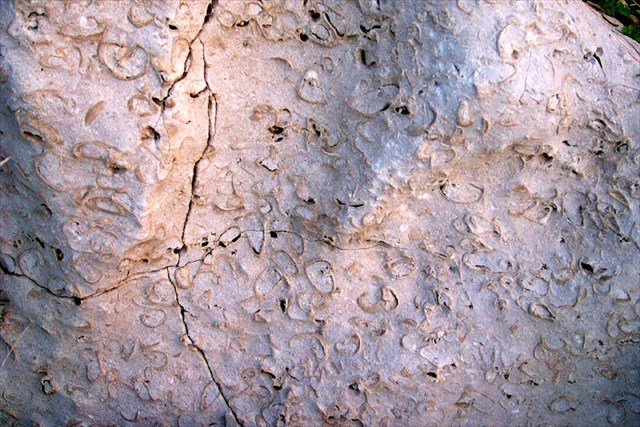LA GROTTE BRILLEHAUT

Le Bois de Brillehaut constitue une vaste entité boisée de plus de 300 ha, de telles surfaces deviennent rares face à une urbanisation croissante et aux pressions agricoles. L'autre originalité de ce bois est de présenter une diversité de milieu allant du plus humide au plus sec. Sur le plateau, domine une chênaie-charmaie composée du Chêne pédonculé (Quercus robur), de Charme (Carpinus betulus), de Tilleul (Tilia cordata), de Châtaignier (Castanea sativa). Parfois, la chênaie fait place à une bétulaie probablement à la faveur d'affleurement sableux. Les sous bois sont composés d'Anémone sylvie (Anemone nemorasa) et de Jacinthe des bois (Hyacynthoides non-scrpta). Des plantations d'Epicéa (Picea sp.) ou de Pin maritime (Pinus pinaster) s'intercale ça et là. L'une des originalités de cette zone est la présence, au nord, sur des argiles du sparnatien, de nombreuses sources calcaires où s'est développé un bois humide composé de Frêne (Fraxinus excelsior), d'Aulne (Alnus glutinos) et d'Erable sycomore (Acer pseudoplatanus). Une espèce déterminante de ZNIEFF, la Prêle d'Ivoire (Equsietum telmateia), trouve ici des conditions idéales à son développement, tout comme une multitude de bryophytes dont l'inventaire mériterait d'être approfondi. Sur des calcaires crétacés, subsiste un coteau mais envahi par des fourrés de Prunellier (Prunus spinosa) et d'Aubépine à un style (Crataegus monogyna). La pelouse envahie par le Brachypode penné (Brachypodium pinnatum) conserve encore diverses orchidées communes, et des espèces typiques telles que l'Origan (Origanum vulgare) et le Buplèvre en faux (Bupleurum falcatum) et la Chlore perfoliée (Blackstonia perfoliata), déterminante de ZNIEFF. Ces milieux présentent un potentiel pour de nombreux insectes comme les papillons ou les criquets. Un petit cours d'eau, le Vigneux coule au pied du coteau. Plusieurs mares constituent des sites de reproduction pour les amphibiens. A l'exception du bois humide et des sources qui sont fragiles de par leur superficie réduite et du coteau qui se ferme progressivement, l'ensemble du site ne présente pas de menace particulière. Une partie du bois de Brillehaut (184 hectares) est un bois communal. Des aménagements ont d'ailleurs été réalisés par la commune afin de valoriser ce patrimoine naturel.
CALCAIRE CRETACE


Le Crétacé (latin : cretaceus = de craie, de creta = craie) est une épaisse formation géologique sédimentaire qui marque la fin du Mésozoïque et qui a été nommée ainsi parce que la craie en est la roche prédominante. Le terrain crétacé est principalement constitué par des couches qui se sont déposées au fond des mers existant à cette époque.
En émergeant du sein des flots, il a formé la bordure des deux mers qui couvraient alors l'une le Nord et l'autres le Sud de l'Europe. L'emplacement de Paris se trouvait alors dans l'intérieur d'un golfe qui terminait au Sud-Ouest la mer septentrionale.
QUESTIONS:
1- Quel est la nature de la roche à l'extérieur de la grotte ?
2- Quel épaisseur fait la couche de silex entre les 2 partie de calcaire crétacé ?
3- A l'entrée ce trouve deux lettres (HINT) quelles sont-elles ?
"Loguez cette cache "Found it" et envoyez-moi vos propositions de réponses soit via mon profil, soit via la messagerie geocaching.com (Message Center), et je vous contacterai en cas de problème."

THE CAVE BRILLEHAUT

The wood is a vast wooded Brillehaut entity of more than 300 ha of such surfaces become rare face increasing urbanization and agricultural pressures. Another originality of this wood is to present a diverse environment ranging from wetter drier. On set, oak-hornbeam dominates composed of English Oak (Quercus robur), House (Carpinus betulus), linden (Tilia cordata), Chestnut (Castanea sativa). Sometimes the oak forest gives way to a birch likely to favor sandy outcrop. The woods are composed of sub sylvie Anemone (Anemone nemorasa) and Bluebell (Hyacynthoides non-scrpta). Plantations Spruce (Picea sp.) Or maritime pine (Pinus pinaster) is inserted here and there. One of the original of this area is the presence in the north, on the sparnatien clays, limestone many sources which grew moist wood composed of Ash (Fraxinus excelsior), Alder (Alnus glutinos) and 'Sycamore Maple (Acer pseudoplatanus). A key species ZNIEFF, Ivory Horsetail (Equsietum telmateia) is here ideal conditions for its development, as a multitude of bryophytes whose inventory deserve to be deepened. By Cretaceous limestones, but still a hillside overgrown with thickets of blackthorn (Prunus spinosa) and hawthorn to a style (Crataegus monogyna). The lawn invaded by penné Brachypodium (Brachypodium pinnatum) still retains various common orchids, and typical species such as oregano (Origanum vulgare) and false in Bupleurum (Bupleurum falcatum) and perfoliée Chlorine (Blackstonia perfoliata), of decisive ZNIEFF. These environments have the potential for many insects such as butterflies or grasshoppers. A small stream, the Vigneux flows at the foot of the hill. Several pools are breeding grounds for amphibians. With the exception of wet wood and springs that are fragile because of their small size and the slope that gradually closes, the entire site presents no particular threat. Part of the wood Brillehaut (184 hectares) is a municipal wood. Adjustments have also been made by the municipality to enhance this natural.
CALCAREOUS CRETACEOUS

The Cretaceous (Latin: cretaceus = chalk, creta = chalk) is a thick sedimentary geological formation that marks the end of the Mesozoic and was so named because the chalk is the predominant rock. The Cretaceous is mainly constituted by layers that were deposited at the bottom of the existing seas at that time.
In emerging from the bosom of the waves, he formed the border of the two seas which then covered one North and other Southern Europe. The Paris location was then in the interior of a gulf that ended at the northern West Wed.
QUESTIONS
1- What is the nature of the rock outside the cave?
2- What made the flint thick layer between two of Cretaceous calcareous?
3- At the entrance is the two letters (HINT) what are they?
"Phones Sign the cache" Found it "and send me your answers proposals or via my profile or via geocaching.com messaging (Message Center), and I will contact you in case of problems."
